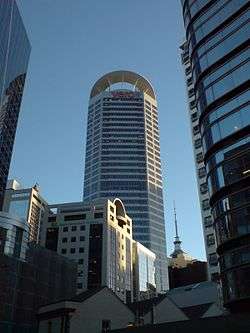Vero Centre
| Vero Centre | |
|---|---|
|
The building from the north | |
| General information | |
| Status | Complete |
| Type | Office tower |
| Location | Shortland Street, Auckland City |
| Coordinates | 36°50′48.14″S 174°46′5.93″E / 36.8467056°S 174.7683139°ECoordinates: 36°50′48.14″S 174°46′5.93″E / 36.8467056°S 174.7683139°E |
| Completed | 2000 |
| Owner | Kiwi Income Property Trust |
| Height | |
| Architectural | 172 m (564.3 ft) |
| Roof | 167.5 m (549.5 ft) |
| Technical details | |
| Floor count | 38 |
| Floor area |
68,900 m2 (741,630 sq ft) gross 39,450 m2 (425,000 sq ft) lettable 4,250 m2 (46,000 sq ft) site area |
| Lifts/elevators | 12 |
| Design and construction | |
| Architect | PTW Architects |
| Developer | Kiwi Income Property Trust |
| References | |
| [1] | |
The Vero Centre (constructed as the Royal & SunAlliance Centre)[1] is a high rise office tower located in Auckland, New Zealand. Constructed in 2000, it was Auckland's first major tower built since the 1980s. The centre contains a health club and gymnasium, main entry public foyer, retail outlets in the 5 podium levels and 32 office levels. As of 2005, it is New Zealand’s tallest landmark office tower. It is also known for its 'halo' roof feature.[1]
While atypically tall compared to the surrounding area, its construction is considered to have had a positive effect on the regeneration of the eastern Auckland CBD area.[1] The site had previously been occupied by a number of vacant lots and low-rise buildings, including student accommodation, industrial warehouses and massage parlours.
The developer's design process made use of the "bonus provisions" of the District Plan, allowing them to build more floor area in exchange for public benefits such as displayed works of art and a public plaza. The value of these to the general public has however been called into question by some. Also criticised has been the lack of connection between the two frontage streets through the building.[1]
The building received several awards for energy efficiency (such as the RICS International Award for Building Efficiency and Regeneration in 2001 and the EnergyWise Award 2004), and has been calculated to use around 10% less energy than the average New Zealand Property Council building.[1] The building houses a number of commissioned artworks, including Coral, by New Zealand sculptor Peter Roche.[2]
See also
References
| Wikimedia Commons has media related to Vero Centre. |
- 1 2 3 4 5 6 Urban Design Case Studies - New Zealand Ministry for the Environment, March 2005, ISBN 0-478-18995-8
- ↑ "Vero Centre - Art Gallery". www.verocentre.co.nz. Retrieved 2016-03-13.
